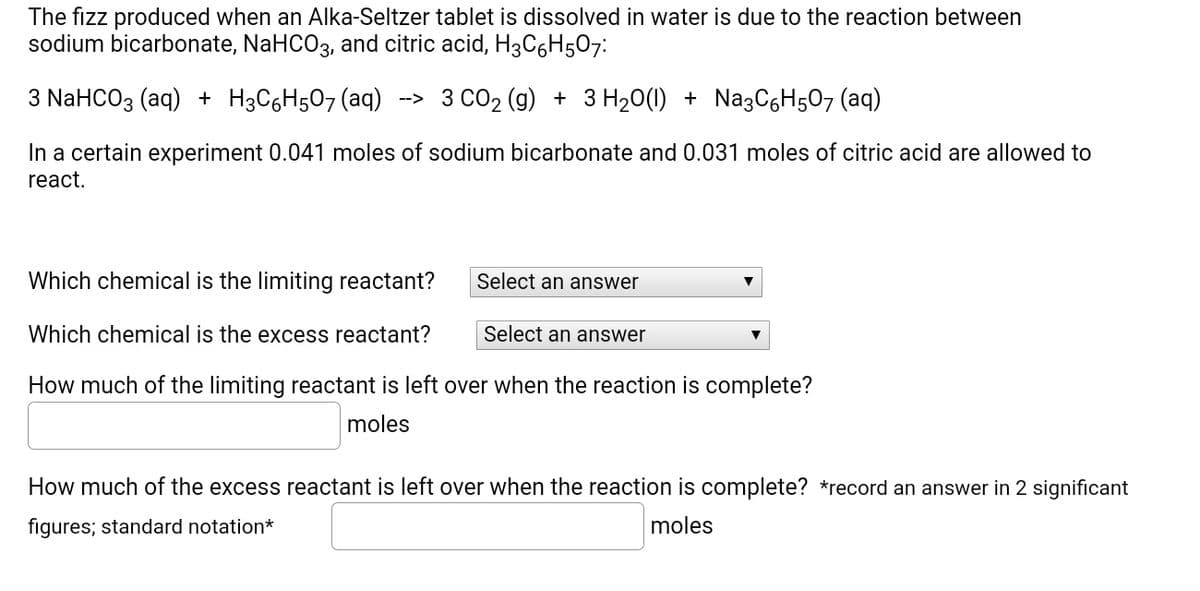The fizz produced when an Alka-Seltzer tablet is dissolved in water is due to the reaction between sodium bicarbonate, NaHCO3, and citric acid, H3C6H507: 3 NaHCO3 (aq) + H3C6H507 (aq) --> 3 CO2 (g) + 3 H20(1) + Na3C6H507 (aq) In a certain experiment 0.041 moles of sodium bicarbonate and 0.031 moles of citric acid are allowed to react. Which chemical is the limiting reactant? Select an answer Which chemical is the excess reactant? Select an answer How much of the limiting reactant is left over when the reaction is complete? moles How much of the excess reactant is left over when the reaction is complete? *record an answer in 2 significant figures; standard notation* moles
The fizz produced when an Alka-Seltzer tablet is dissolved in water is due to the reaction between sodium bicarbonate, NaHCO3, and citric acid, H3C6H507: 3 NaHCO3 (aq) + H3C6H507 (aq) --> 3 CO2 (g) + 3 H20(1) + Na3C6H507 (aq) In a certain experiment 0.041 moles of sodium bicarbonate and 0.031 moles of citric acid are allowed to react. Which chemical is the limiting reactant? Select an answer Which chemical is the excess reactant? Select an answer How much of the limiting reactant is left over when the reaction is complete? moles How much of the excess reactant is left over when the reaction is complete? *record an answer in 2 significant figures; standard notation* moles
Chemistry for Engineering Students
3rd Edition
ISBN:9781285199023
Author:Lawrence S. Brown, Tom Holme
Publisher:Lawrence S. Brown, Tom Holme
Chapter4: Stoichiometry
Section: Chapter Questions
Problem 4.77PAE: The pictures below show a molecular-scale view of a chemical reaction between H2 and CO to produce...
Related questions
Question

Transcribed Image Text:The fizz produced when an Alka-Seltzer tablet is dissolved in water is due to the reaction between
sodium bicarbonate, NaHCO3, and citric acid, H3C6H507:
3 NaHCO3 (aq) + H3C6H507(aq)
--> 3 CO2 (g) + 3 H20(1) + NazC6H5O7 (aq)
In a certain experiment 0.041 moles of sodium bicarbonate and 0.031 moles of citric acid are allowed to
react.
Which chemical is the limiting reactant?
Select an answer
Which chemical is the excess reactant?
Select an answer
How much of the limiting reactant is left over when the reaction is complete?
moles
How much of the excess reactant is left over when the reaction is complete? *record an answer in 2 significant
figures; standard notation*
moles
Expert Solution
This question has been solved!
Explore an expertly crafted, step-by-step solution for a thorough understanding of key concepts.
This is a popular solution!
Trending now
This is a popular solution!
Step by step
Solved in 3 steps with 2 images

Knowledge Booster
Learn more about
Need a deep-dive on the concept behind this application? Look no further. Learn more about this topic, chemistry and related others by exploring similar questions and additional content below.Recommended textbooks for you

Chemistry for Engineering Students
Chemistry
ISBN:
9781285199023
Author:
Lawrence S. Brown, Tom Holme
Publisher:
Cengage Learning

Chemistry: Principles and Practice
Chemistry
ISBN:
9780534420123
Author:
Daniel L. Reger, Scott R. Goode, David W. Ball, Edward Mercer
Publisher:
Cengage Learning

Chemistry by OpenStax (2015-05-04)
Chemistry
ISBN:
9781938168390
Author:
Klaus Theopold, Richard H Langley, Paul Flowers, William R. Robinson, Mark Blaser
Publisher:
OpenStax

Chemistry for Engineering Students
Chemistry
ISBN:
9781285199023
Author:
Lawrence S. Brown, Tom Holme
Publisher:
Cengage Learning

Chemistry: Principles and Practice
Chemistry
ISBN:
9780534420123
Author:
Daniel L. Reger, Scott R. Goode, David W. Ball, Edward Mercer
Publisher:
Cengage Learning

Chemistry by OpenStax (2015-05-04)
Chemistry
ISBN:
9781938168390
Author:
Klaus Theopold, Richard H Langley, Paul Flowers, William R. Robinson, Mark Blaser
Publisher:
OpenStax

Chemistry: Principles and Reactions
Chemistry
ISBN:
9781305079373
Author:
William L. Masterton, Cecile N. Hurley
Publisher:
Cengage Learning

Chemistry
Chemistry
ISBN:
9781305957404
Author:
Steven S. Zumdahl, Susan A. Zumdahl, Donald J. DeCoste
Publisher:
Cengage Learning
